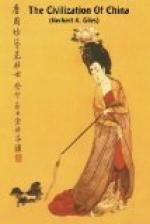Reference has been made above to journeys performed by boat. In addition to the Yangtsze and the Yellow River or Hoang ho (pronounced Hwong haw), two of the most important rivers in the world, China is covered with a network of minor streams, which in southern China form the chief lines of transport. The Yangtsze is nothing more than a huge navigable river, crossing China Proper from west to east. The Yellow River, which, with the exception of a great loop to the north, runs on nearly parallel lines of latitude, has long been known as “China’s Sorrow,” and has been responsible for enormous loss of life and property. Its current is so swift that ordinary navigation is impossible, and to cross it in boats is an undertaking of considerable difficulty and danger. It is so called from the yellowness of its water, caused by the vast quantity of mud which is swept down by its rapid current to the sea; hence, the common saying, “When the Yellow River runs clear,” as an equivalent of the Greek Kalends. The huge embankments, built to confine it to a given course, are continually being forced by any unusual press of extra water, with enormous damage to property and great loss of life, and from time to time this river has been known to change its route altogether, suddenly diverging, almost at a right angle. Up to the year 1851 the mouth of the river was to the south of the Shantung promontory, about lat. 34 N.; then, with hardly any warning, it began to flow to the north-east, finding an outlet to the north of the Shantung promontory, about lat. 38 N.
A certain number of connecting links have been formed between the chief lines of water communication, in the shape of artificial cuttings; but there is nothing worthy the name of canal except the rightly named Grand Canal, called by the Chinese the “river of locks,” or alternatively the “transport river,” because once used to convey rice from the south to Peking. This gigantic work, designed and executed in the thirteenth century by the Emperor Kublai Khan, extended to about six hundred and fifty miles in length, and completed an almost unbroken water communication between Peking and Canton. As a wonderful engineering feat it is indeed more than matched by the famous Great Wall, which dates back to a couple of hundred years before Christ, and which has been glorified as the last trace of man’s handiwork on the globe to fade from the view of an imaginary person receding into space. Recent exploration shows that this wall is about eighteen hundred miles in length, stretching from a point on the seashore somewhat east of Peking, to the northern frontier of Tibet. Roughly speaking, it is twenty-two feet in height by twenty feet in breadth; at intervals of a hundred yards are towers forty feet high, the whole being built originally of brick, of which in some parts but mere traces now remain. Nor is this the only great wall; ruins of other walls on a considerable scale have lately been brought to light, the object of all being one and the same—to keep back the marauding Tartars.




